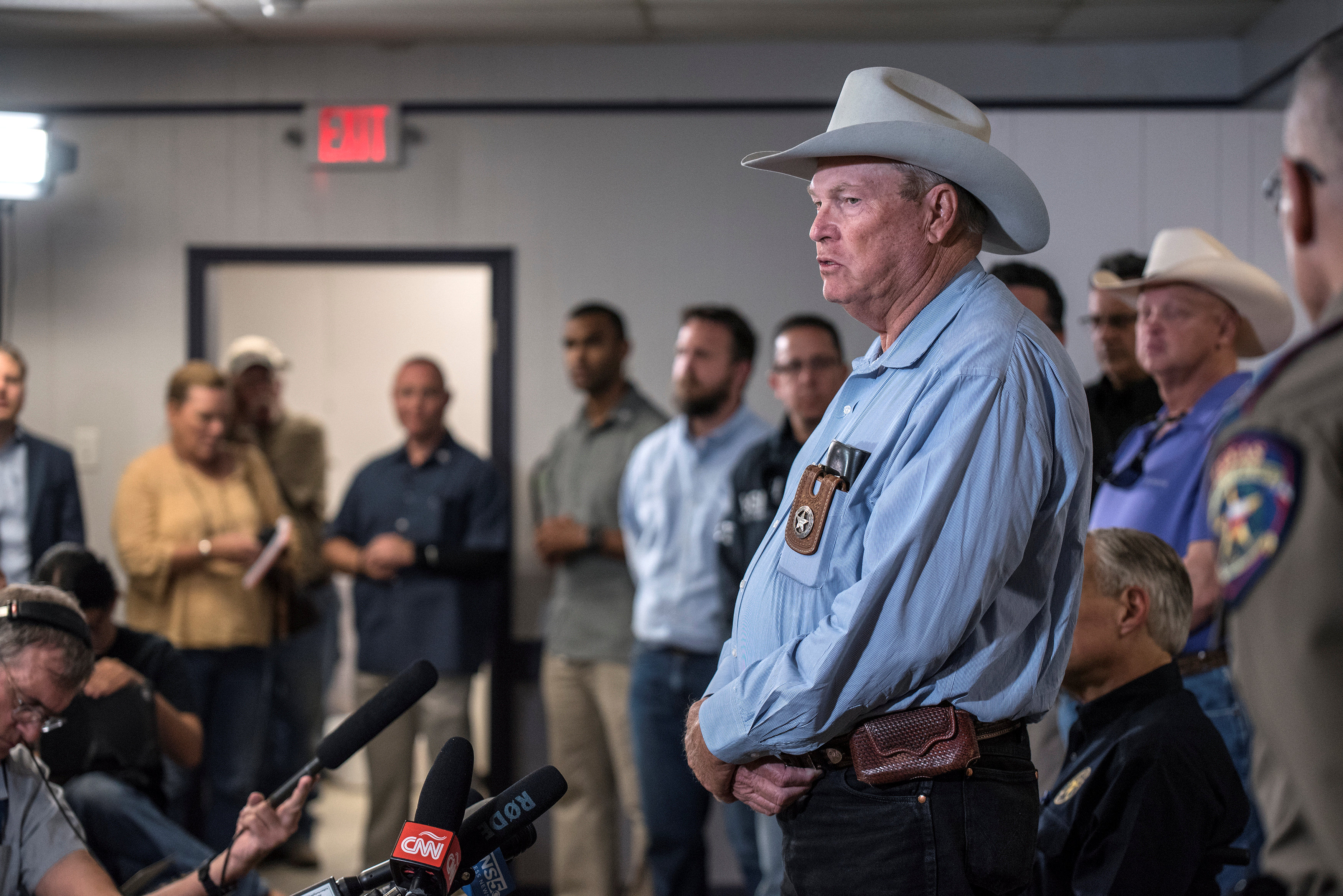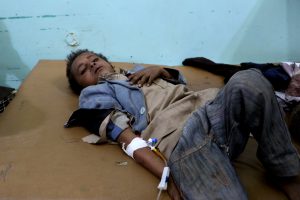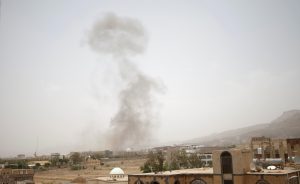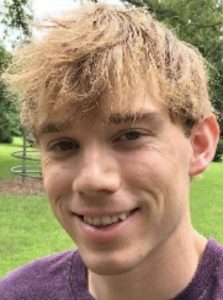
By Lisa Maria Garza
SUTHERLAND SPRINGS, Texas (Reuters) – A man with an assault rifle killed at least 26 people and wounded 20 in a rural Texas church during Sunday services, adding the name of Sutherland Springs to the litany of American communities shattered by mass shootings.
The massacre, which media reports say was carried out by a man thrown out of the Air Force for assaulting his wife and child, is likely to renew questions about why someone with a history of violence could amass an arsenal of lethal weaponry.
The lone gunman, dressed in black tactical gear and a ballistic vest, drove up to the white-steepled First Baptist Church in Sutherland Springs and started firing inside. He kept shooting once he entered, killing or wounding victims ranging in age from five to 72 years, police told a news conference.

The area around a site of a mass shooting is taped out in Sutherland Springs, Texas, U.S., November 5, 2017, in this picture obtained via social media. MAX MASSEY/ KSAT 12/via REUTERS
President Donald Trump told reporters the shooting was due to a “mental health problem” and wasn’t “a guns situation.” He was speaking during an official visit to Japan.
Among the dead was the 14-year-old daughter of church Pastor Frank Pomeroy, the family told several television stations. One couple, Joe and Claryce Holcombe, told the Washington Post they lost eight extended family members, including their pregnant granddaughter-in-law and three of her children.
The gunman was later found dead, apparently of a gunshot wound, after he fled the scene.
“We are dealing with the largest mass shooting in our state’s history,” Texas Governor Greg Abbott told a news conference. “The tragedy of course is worsened by the fact that it occurred in a church, a place of worship.”
About 40 miles (65 km) east of San Antonio in Wilson County, Sutherland Springs has fewer than 400 residents.
“This would never be expected in a little county like (this),” Texas Attorney General Ken Paxton told CNN.
A local resident with a rifle fired at the suspect as he left the church. The gunman dropped his Ruger assault weapon and fled in his vehicle, said Freeman Martin, regional director of the Texas Department of Public Safety.
A man told San Antonio television station KSAT he was driving near the church when the resident who had opened fire on the gunman approached his truck and urged him to give chase.
“He said that we had to get him (the gunman), and so that’s what I did,” Johnnie Langendorff, the driver of the truck, told KSAT. He added they reached speeds of 95 miles (153 km/h) per hour during the chase, while he was on the phone with emergency dispatchers.
Soon afterward, the suspect crashed the vehicle near the border of a neighboring county and was found dead inside with a cache of weapons. It was not immediately clear if he killed himself or was hit when the resident fired at him outside the church, authorities said.
The suspect’s identity was not disclosed by authorities, but law enforcement officials who asked not to be named said he was Devin Patrick Kelley, described as a white, 26-year-old man, the New York Times and other media reported.
“We don’t think he had any connection to this church,” Wilson County Sheriff Joe Tackitt told CNN. “We have no motive.”

Wilson County Sheriff Joe Tackett gives an update during a news conference at the Stockdale Community Center following a shooting at the First Baptist Church in Sutherland Springs that left many dead and injured in Stockdale, Texas, U.S., November 5, 2017. REUTERS/Sergio Flores
‘I HIT THE DECK’
The massacre came weeks after a sniper killed 58 people in Las Vegas. It was the deadliest attack in modern U.S. history and rekindled a years-long national debate over whether easy access to firearms was contributing to the trend of mass shootings.
In rural areas like Sutherland Springs, gun ownership is a part of life and the state’s Republican leaders for years have balked at campaigns for gun control, arguing that more firearms among responsible owners make the state safer.
Jeff Forrest, a 36-year-old military veteran who lives a block away from the church, said what sounded like high-caliber, semi-automatic gunfire triggered memories of his four combat deployments with the Marine Corps.
“I was on the porch, I heard 10 rounds go off and then my ears just started ringing,” Forrest said. “I hit the deck and I just lay there.”
To honor the victims, Trump ordered flags on all federal buildings to be flown at half staff.
In Japan during the first leg of a 12-day Asian trip, the president said preliminary reports indicated the shooter was “deranged.”
“This isn’t a guns situation, I mean we could go into it, but it’s a little bit soon to go into it,” Trump said. “But fortunately somebody else had a gun that was shooting in the opposite direction, otherwise … it would have been much worse. But this is a mental health problem at the highest level.”
The First Baptist Church is one of two houses of worship in Sutherland Springs, which also has two gas stations and a Dollar General store.
The white-painted, one-story church features a small steeple and a single front door. On Sunday, the Lone Star flag of Texas was flying alongside the U.S. flag and a third, unidentified banner.
Inside, there is a small raised platform on which members sang worship songs to guitar music and the pastor delivered a weekly sermon, according to videos posted on YouTube. In one of the clips, a few dozen people, including young children, can be seen sitting in the wooden pews.
It was not clear how many worshipers were inside when Sunday’s shooting occurred.
SOCIAL MEDIA PRESENCE
Online records show a man named Devin Patrick Kelley lived in New Braunfels, Texas, about 35 miles (56 km) north of Sutherland Springs.
The U.S. Air Force said Kelley served in its Logistics Readiness unit at Holloman Air Force Base in New Mexico from 2010 until his discharge in 2014.
Kelley was court-martialed in 2012 on charges of assaulting his wife and child, and given a bad-conduct discharge, confinement for 12 months and a reduction in rank, Air Force spokeswoman Ann Stefanek said.
Kelley’s Facebook page has been deleted, but cached photos show a profile picture where he appeared with two small children. He also posted a photo of what appeared to be an assault rifle, writing a post that read: “She’s a bad bitch.”
Sunday’s shooting occurred on the eighth anniversary of the Nov. 5, 2009, massacre of 13 people at the Fort Hood Army base in central Texas. A U.S. Army Medical Corps psychiatrist convicted of the killings is awaiting execution.
In 2015, a white gunman killed nine black parishioners at Emanuel African Methodist Episcopal Church in Charleston, South Carolina. The gunman was sentenced to death for the racially motivated attack.
In September, a gunman killed a woman in the parking lot of a Tennessee church and wounded six worshipers inside.
(Additional reporting by Bernie Woodall in Fort Lauderdale, Fla., Jon Herskovitz in Austin, Texas, Phil Stewart in Washington, and Alex Dobuzinskis in Los Angeles; writing by Frank McGurty; editing by Mark Heinrich)











